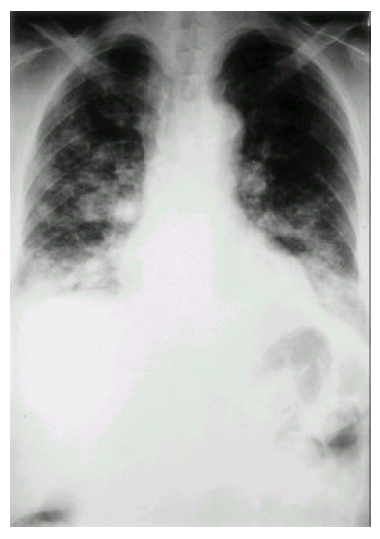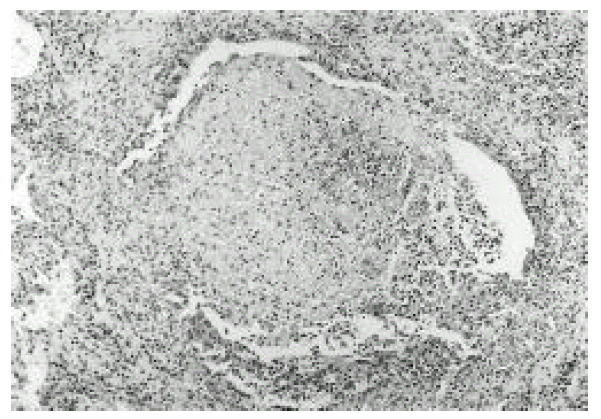Chronic Necrotizing Bronchopulmonary Aspergillosis With Elements of Bronchocentric Granulomatosis
Article information
Abstract
Chronic necrotizing pulmonary aspergillosis (CNPA) is an unusual form of pulmonary aspergillosis arising in the setting of mildly immune compromised state or altered local defense system. CNPA rarely shows histological findings mimicking bronchocentric granulomatosis (BCG), which is characterized by peribronchiolar granulomatous destruction. We describe a case representing CNPA with elements of BCG. A-64 year-old woman was admitted because of atypical pneumonia with multi-focal variable sized consolidations and cavitary lesions on high-resolution computed tomography (HRCT). The open lung biopsy specimen showed large areas of necrotizing pneumonia with some scattered aspergillus hyphae within the lung parenchyma. Some terminal bronchioles were found to be destroyed and were replaced by peribronchiolar granulomatous inflammation. There was no evidence of angioinvasion by aspergillus or aspergillous emboli. Despite vigorous antifungal agent and steroid treatment, she died of acute airway obstruction by bronchial casts on the thirty-fourth hospital day.
INTRODUCTION
An aspergillus infection of the lung produces a wide range spectrum of disease which is dependent on the underlying lung architecture, the host’s immune response and the degree of inoculums1). Chronic necrotizing pulmonary aspergillosis (CNPA) is an unusual form of pulmonary aspergillosis arising in the setting of mildly immune compromised state or altered local defense system, such as preexisting pulmonary disease. CNPA is defined as an indolent, cavitating and progressive disease that often resembles tuberculosis2, 3).
Bronchocentric granulomatosis (BCG), which was first described by Liebow in 19734), is characterized by peribronchiolar granulomatous lung destruction without tissue invasion4–6). It often occurs as a rare subset of allergic bronchopulmonary aspergillosis (ABPA). But only 34% of patients are asthmatics5, 6). BCG is a distinct entity of disease from CNPA but BCG-mimicking histological findings rarely occur in CNPA7, 8). We report a case representing CNPA with pathologic findings of BCG.
CASE REPORT
A 64-year-old woman was referred to our hospital for bronchial asthma with atypical pneumonia unresolved by antibiotic treatment. She had no history of being diagnosed as asthma but had suffered from intermittent sensation of chest constriction by exposure to cold air.
She had taken steroid for her joint arthritis without consulting a doctor for several years. She has never smoked and had no history of tuberculosis, diabetes mellitus or other cardiovascular disease. About 20 days before admission, the patient suffered from fever, cough, sputum and dyspnea. She visited another hospital and was treated with antibiotics and steroids. Despite treatment, there was no clinical improvement of her symptoms. She was referred to our hospital for further evaluation.
On admission, her body temperature was 37.2°C, pulse rate was 110/min, respiration rate was 24/min and blood pressure was 160/100 mmHg. Physical examination revealed bilateral diffuse inspiratory crackle without wheezing. Laboratory tests were performed: white blood cell count was 48,220/μL (neutrophils were 98%, monocytes 1% and lymphocytes 1%), hemoglobin 11.2 g/dL, hematocrit 32.1% and platelet count 394,000/μL on complete blood cell counts. Arterial blood gas analysis findings were pH 7.497, PaCO2 42.5 mmHg, PaO2 63.4 mmHg, bicarbonate 32.6 mmol/L and oxygen saturation 93.3% on oxygen 3 L/min via nasal prong. Sodium was 126 mEq/L, potassium 2.7 mEq/L, chloride 98 mEq/L, urea nitrogen 13.9 mg/dL, creatinine 1.24 mg/dL, cholesterol 168 mg/dL, total protein 5.1 mg/dL, albumin 2.6 mg/dL, AST 22 IU/L, ALT 22 IU/L and total bilirubin was 0.82 mg/dL on blood chemistry. Chest radiography and high-resolution computed tomography (HRCT) showed multifocal variable-sized consolidation with reticulonodular opacities (Figure 1) and cavitary lesion in both upper lobes and right lower lobe. There were also multiple small nodular densities and ground glass attenuation around the consolidation (Figure 2A, B).

Chest radiograph shows bilateral variable-sized multifocal consolidation with reticulonodular opacities. Note a cavitary lesion in the left lower lung zone.

(A) High-resolution computed tomography shows multifocal variable-sized consolidation. (B) Cavitary lesions in both upper and right lower lobes formed by expectoration of mucus from ectatic bronchi. There were multiple small nodular densities and ground glass attenuation around consolidation.
Microscopic examination of sputum showed no acid-fast bacilli. Other laboratory findings, including IgG, IgM, IgA, IgE PRIST, C3, C4, CH50, rheumatoid factor (RF), antinuclear antibody (ANA), anti-neutrophil cytoplasmic antibody (ANCA), antistreptolysin-O (ASO), VDRL and cold cryoglobulin, were all negative.
Despite empiric broad-spectrum antibiotics and steroid treatment, dyspnea progressively aggravated. Open lung biopsy was done on the tenth hospital day. Histopathologic findings of the biopsy specimen showed large areas of necrotizing pneumonia with an infarct-like appearance (Figure 3A). There were some scattered fungal hyphae within the lung parenchyma (Figure 3B). The bronchi and bronchioles often showed dilated lumen which were filled with mucus, numerous necrotic debris, inflammatory cells and branching septated hyphae characteristic of aspergillus. Some terminal bronchioles were found to be destroyed and were replaced by granulomatous inflammation (Figure 4). The bronchocentric granulomatous reaction extended into the adjacent lung parenchyma to a degree. Gomori-Methenamine-Silver (GMS) staining revealed many fungal hyphae consistent with aspergillus species. There was no evidence of angioinvasion by aspergillus or aspergillous emboli. With an impression of invasive aspergillus infection with BCG-like elements, 15 mg of amphotericin-B once day was administered intravenously and the dose was increased up to 30 mg daily. Steroids was tapered progressively. There were some improvement in her clinical symptoms. However despite vigorous antifungal treatment, sudden respiratory arrest occurred due to acute tracheobronchial tree obstruction with bronchial casts on the thirty-fourth hospital day. Histopathologic examination of the casts revealed fibrinoid necrotic tissue containing neutrophils, a few metaplastic squamous cell nests and variably fragmented fungal hyphae (Figure 5).

Histological findings of chronic necrotizing pulmonary aspergillosis. (A) Focus of necrotizing pneumonia with an infarct-like appearance (H&E, ×200). (B) Gomori-Methenamine Silver stain showing scattered fragments of fungal hyphae characteristic of aspergillus species (GMS, ×200).

Histologic section of the lung reveals a bronchocentric granulomatous-like appearance with a necrotizing granulomatous bronchiolitis with luminal necrotic debris and replacement by a palisaded histiocytic reaction (H&E, ×200).
DISCUSSION
Pulmonary aspergillosis is a general term for the lung disease caused by the genus aspergillus. It produces a wide spectrum of disease, ranging from saprophytic colonization to hypersensitivity reactions to necrotizing pneumonia with or without angioinvasion, which is dependent on the underlying lung architecture, the host’s immune response and the degree of inoculums1–3, 7, 9). In 1981, Gefter et al. suggested an additional form of low-grade invasive aspergillosis, which is called “semi-invasive pulmonary aspergillosis”2). A few months later, Binder et al. described a similar locally invasive form of disease that he called “chronic necrotizing pulmonary aspergillosis (CNPA)”3). Patients with CNPA are often chronically ill with complaints of fever, productive cough, hemoptysis and weight loss. Chronic infiltration may be evident on chest radiographs and may progress to form cavitary lesions or aspergilloma1–3, 7–10). Leukocytosis may be present on complete blood cell count. In contrast to invasive aspergillosis, which is generally associated with extensive angioinvasion and embolic spread with little or no cellular or fibrous reaction, CNPA is generally characterized by local penetration into tissue, but this process is contained by cellular or fibrous reaction. Disseminative disease is uncommon and has poor prognosis despite systemic antifungal treatment1–3, 7–10).
Hypersensitivity reactions of pulmonary aspergillosis are manifested by allergic bronchial asthma, allergic bronchopulmonary aspergillosis (ABPA), bronchocentric granulomatosis (BCG) and extrinsic allergic alveolitis1–13). Among these, BCG is an uncommon inflammatory lesion of unknown etiology and is defined on morphologic grounds by necrotizing granulomatous replacement of mucous membrane of bronchi and bronchioles and when aspergillus organisms are present, some bronchocentric granulomas with tissue eosinophilia are regarded as a hypersensitivity reaction to inhaled aspergillus4–6, 9, 11). The main treatment of allergic aspergillosis rests on immune suppressive agents, such as long-term use of prednisolone5, 6, 9).
CNPA and BCG have immunologically distinct pathogenic mechanisms. CNPA occurs in mildly immune-compromised patients, whereas BCG is considered as a severe type of hypersensitivity reaction in hyper-reactive patients1–11). However, CNPA occasionally shows histological findings mimicking BCG8). Because the treatment of these diseases is quite different-that of CNPA depends on antifungal agents whereas that of BCG rests on immunosuppressive agents - it is important to distinguish them by their specific disease spectrum. The history of suspicious asthma, the findings of ectatic bronchi and cavitary lesions of this case are characteristic of various forms of chronic intrabronchial aspergillosis, including BCG. Even thoueh this case is not an example of classic immunosuppression but a history of suspicious asthma, a history of long-term steroid use, underlying pulmonary disease with ectatic bronchi, the use of broad spectrum antibiotics and the presence of aspergillus organism enable us to suspect the substantial immunosupression of patients12). All these factors probably resulted in immunosupression to a degree sufficient to permit the development of invasive disease from non-invasive forms13).
In summary, BCG with aspergillus is regarded as non-invasive, hypersensitive reaction, but CNPA is an invasive disease occurring in a mildly immune compromised state. CNPA is not associated with allergic mucin, has neutrophils (not eosinophils) as a dominant component, shows evidence of fungal invasion of lung parenchyma and has no history of asthma7, 8). Even though the pathologic findings of this case showed the elements of BCG, there was no evidence of blood and tissue eosinophilia and no elevation of serum levels of IgE and IgG antibodies. In addition, the progression, despite immune-suppressive therapy, suggests that this case represents CNPA with elements of BCG. This case is notable because of the presence of invasive disease usually occurring in an immuocompromised state-CNPA with cavitary necrosis-and the non-invasive hypersensitivity disease-BCG. It is also important because it provides the clue, that chronic immune suppression may induce the progression of non-invasive hypersensitivity disease to invasive disease. But, in order to define the relationship between bronchocentric granulomatous reaction and CNPA, more reports and prospective studies on patients with saprophytic or hypersensitivity forms of aspergillosis, in whom the infection progressed to the invasive disease, will be needed.
